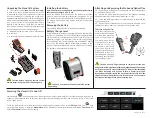
Chapter Three: Overview
System Design Elements
93
Mass Flow Control
The MFC board allows the 146 instrument to communicate with mass flow controllers (MFCs)
to regulate the flow of gas into a system. The 146 instrument can operate in either set point,
totaling, or ratio flow control mode. To select which parameter to use for control, refer to Code
17x: Adjust MFC Set Point, Mode, and Co-channel in the Operation in Setup Mode chapter. To
select the MFC as the controlling channel, refer to Code 14x: How To Select Polarity and the
Control Channel also in the Operation in Setup Mode chapter.
Set Point Mode of Operation
When using the Set Point mode of operation, the 146 instrument sends out a voltage
corresponding to a user-defined set point (in sccm). The set point voltage takes into account any
zero offset which may have resulted from zeroing the MFC, to ensure that the MFC controls to
the desired flow rate. The 146 instrument can operate up to four MFCs. Each MFC operating in
Set Point mode has a set point value assigned to it.
Totaling Mode of Operation
When using the Totaling mode of operation, two MFCs operate in conjunction with each other.
One MFC (defined as the co-channel), operates according to a fixed set point. The other MFC,
defined as the totaling MFC, adjusts its output voltage to maintain a user-defined total flow rate
(set point) for the system. For example, you want to maintain a flow rate of 100 sccm. Enter a
set point of 100 sccm and set the co-channel to a fixed flow rate of 20 sccm. The totaling MFC
will subtract 20 (flow rate of the co-channel) from 100 (the set point) and adjust its voltage to
produce a flow rate of 80 sccm. Therefore, the total flow rate will be 100 (20 + 80). As with the
Set Point mode of operation, the 146 instrument accounts for any zero offset.
Ratio Flow Control Mode of Operation
In a Ratio control mode, the 146 instrument is capable of controlling up to four MFCs. The 146
uses a pressure control signal (PCS), or a total flow signal, as feedback. The Ratio mode uses a
logical control channel to execute the PID control algorithm and achieve the desired gas ratio.
The logical control channel (control channel 0) is present even if no Control board is installed.
The 146 instrument calculates the control signal to correct the gas ratio and sends the signal to all
MFCs configured for Ratio control.
Two possible control methods exist within Ratio mode: control with a pressure measuring
control channel, and control with a flow measuring (MFC) control channel.
The ratio controllers maintain the gas ratio, and the 146 instrument maintains the absolute
pressure by controlling the total flow.
Essentially, the Ratio mode of operation scales and proportions the 0 to 10 Volt control signal
among the MFCs configured for Ratio mode, based on their chosen ratio set points. The set
points can range from 0 to 200%. Since most MFCs accept a 0 to 5 Volt signal, the control
signal for a given MFC is always scaled by ½, then multiplied by the ratio set point percent:
MFC control signal = ½ (control signal)(ratio set point %/100)
Artisan Technology Group - Quality Instrumentation ... Guaranteed | (888) 88-SOURCE | www.artisantg.com
















































